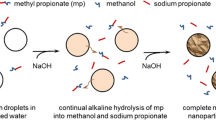Abstract
Purpose. To substitute dichloromethane with a safer solvent, a solvent extraction process using methylethyl ketone (MEK) was developed to prepare poly(d,l-lactide-co-glycolide) microcapsules.
Methods. The MEK dispersed phase containing PLGA and progesterone was emulsified in the MEK-saturated aqueous phase (W1) to make a transient oil-in-water (O/W1) emulsion. It was then transferred to a sufficient amount of water (W2) so that MEK residing in polymeric droplets could be extracted effectively into the continuous phase.
Results. This solvent extraction process provided the encapsulation efficiency for progesterone ranging from 77 to 60%. The amount of MEK predissolved in W1 as well as the degree of progesterone payload, influenced the encapsulation efficiency. The leaching profile of MEK analyzed by GC substantiated that, upon dispersion of O/W1 to W2, MEK quickly diffused into the continuous phase. Such a rapid diffusion of MEK from and the ingression of water into polymeric droplets produced hollow microcapsules, as evidenced by their SEM micrographs.
Conclusions. When solvent extraction/evaporation techniques are employed for preparing PLGA microcapsules, water-immiscibility of a dispersed phase is not an absolute prerequisite to the successful microencapsulation. Adjustment of an initial extraction rate of MEK and formation of a primary transient O/W1 emulsion are found to be very crucial not only for the success of microencapsulation but also for the determination of microcapsule morphology.
Similar content being viewed by others
REFERENCES
P. J. Watts, M. C. Davies, and C. D. Melia. Microencapsulation using emulsification/solvent evaporation: An overview of techniques and applications. Critical Reviews in Therapeutic Drug Carrier Systems 7:235–259 (1990).
R. Bodmeier, and J. W. McGinity. Solvent selection in the preparation of poly(DL-lactide) microspheres prepared by the solvent evaporation method. Int. J. Pharm. 43:179–186 (1988).
W. J. Lambert, and K. D. Peck. Development of an in situ forming biodegradable poly-lactide-co-glycolide system for the controlled release of proteins. J. Control. Release 33:189–195 (1995).
E. Allémann, R. Gurny, and E. Doelker. Drug-loaded nanoparticles—preparation and drug targeting issues. Eur. J. Pharm. Biopharm. 39:173–191 (1993).
Y. Kawashima, T. Niwa, T. Handa, H. Takeuchi, T. Iwamoto, and K. Itoh. Preparation of controlled-release microspheres of ibuprofen with acrylic polymers by a novel quasi-emulsion solvent diffusion method. J. Pharm. Sci. 78:68–72 (1989).
F. Courteille, J. P. Benoit, and C. Thies. The morphology of progesterone-loaded polystyrene microspheres, J. Control. Release 30:17–26 (1994).
C. Bindschaedler, R. Gurny, and E. Doelker. Process for preparing a powder of water-insoluble polymer which can be redispersed in a liquid phase. the resulting powder and utilization thereof. U.S. Patent 4,968,350 (1990).
E. Allémann, R. Gurny, and E. Doelker. Preparation of aqueous polymeric nanodispersions by a reversible salting-out process: influence of process parameters. Int. J. Pharm. 87:247–253 (1992).
R. C. Mehta, R. Jeyanthi, S. Calis, B. C. Thanoo, K.W. Burton, and P.P. DeLuca. Biodegradable microspheres as depot system for parenteral delivery of peptide drugs. J. Control. Release 29:375–384 (1994).
D. R. Cowsar, T. R. Tice, R. M. Gilley, and J. P. English. Poly(lactide-co-glycolide) microcapsules for controlled release of steroids. Methods in Enzymology 112:101–116 (1985).
T. R. Tice, and R. M. Gilley. Preparation of controlled release microcapsules by a solvent evaporation process. J. Control. Release 2:343–352 (1985).
G. Crotts, and T. G. Park. Preparation of porous and nonporous biodegradable polymeric hollow microspheres. J. Control. Release 35:91–105 (1995).
G. Mukherji, R. S. R. Murthy, and B. D. Miglani. Preparation and evaluation of cellulose nanospheres containing 5-fluorouracil. Int. J. Pharm. 65:1–5 (1990).
G. Reich. Preparation and characterization of indomethacin-loaded nanoparticles using poly(D,L-lactide)/Synperonic blends. Proc. 6th Congr. Int. Pharm. Technol. 11:308–316 (1992).
Ch. Schugens, N. Laruelle, N. Nihant, Ch. Grandfils, R. Jerome, and Ph. Teyssie. Effect of the emulsion stability on the morphology and porosity of semicrystalline poly-1-lactide microparticles prepared by w/o/w double emulsion-evaporation. J. Control. Release 32:161–176 (1994).
G. Spenlehauer, M. Veilard, and J. P. Benoit. Formation and characterization of cisplatin loaded poly(d,l-lactide) microspheres for chemoembolization. J. Pharm. Sci. 75:750–755 (1986).
Y. Kawashima, T. Niwa, H. Takeuchi, T. Hino, and Y. Ito. Preparation of multiple unit hollow microspheres (microballons) with acrylic resin containing tranilast and their drug release characteristics (in vitro) and floating behavior (in vivo). J. Control. Release 16:279–290 (1991).
Y. Kawashima, T. Niwa, H. Takeuchi, T. Hino, and Y. Itoh. Hollow microspheres for use as a floating controlled drug delivery system in the stomach. J. Pharm. Sci. 81:135–140 (1992).
Author information
Authors and Affiliations
Rights and permissions
About this article
Cite this article
Sah, H., Smith, M.S. & Chern, R.T. A Novel Method of Preparing PLGA Microcapsules Utilizing Methylethyl Ketone. Pharm Res 13, 360–367 (1996). https://doi.org/10.1023/A:1016080123176
Issue Date:
DOI: https://doi.org/10.1023/A:1016080123176




